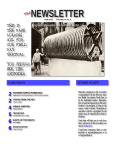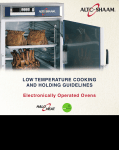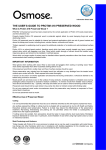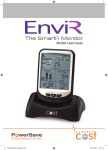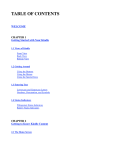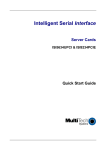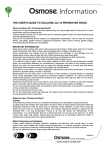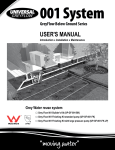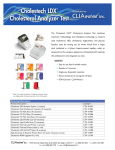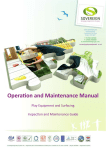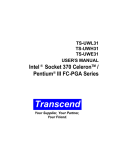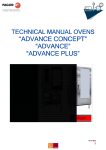Download High Pressure Treated Timber User Guide
Transcript
High Pressure Treated Timber User Guide Important information for users of Osmose Naturewood High-Pressure treated timber What is Osmose Naturewood? Osmose Naturewood preserved wood is the name given to timber that has been preserved with an Osmose preservative system known as Celcure AC-500, which is based on copper and an organic co-biocide (Alkaline Copper Quaternary). Alkaline Copper Quaternary systems have provided proven performance for over a decade in locations throughout Europe, North America, Australia and Japan. Osmose Naturewood preserved wood can be used for fencing, timber decking, landscaping timbers and construction timbers. Osmose Naturewood® can be used to treat all timber in use classes 1-4. Information on the Use Class system is available from PTG Treatments or from BS EN 335-1. Osmose Naturewood® appears in the Wood Protection Association Manual as compliant with EN 599 expectations. What length of service life can be expected? Service life of the treated timber depends upon the species, end use and application rates. In general it can be expected that internal timbers used in Use Class 1 or 2 will last in excess of 60 years. Those timbers exposed to weathering but installed above ground contact will achieve service lives of between15/30 years. Timbers serving in-ground contact such as fence posts can achieve a service life of around 15 years. However care should be taken to choose the correct species for the end-use and to specify the correct level of treatment. How do I specify treatment with Osmose Naturewood? 1) Firstly identify the component end use. 2) Identify the Use Class pertaining to this end use – e.g. fence post = Use Class 4. 3) Identify any special service life considerations – do they differ from those described above? If so consult PTG Treatments for specialist advice. 4) Identify and report the species of the timber to be treated as this has a considerable bearing on suitability for certain treatment process or end uses. Also identify and report the moisture content of the timber. 5) PTG Treatments recommends a form of words such as ‘Timber to be treated to a 15 year service life in Use Class 4 conditions. The species is pine and the moisture content is lower than 28%.’ 6) Specify whether a Treatment Certificate is required. USE CLASS TABLE Use Class (UC) Use 1 Above ground, covered. Permanently dry, insect risk. 2 Above ground, covered. Occasional risk of wetting. 3a Above ground, coated. Exposed to frequent wetting. 3b Above ground, uncoated. Exposed to frequent wetting. 4 In contact with ground or fresh water. Permanently exposed to wetting. Biocidal Product Regulation (EU 528/2012) Article 58 Information Celcure AC-500 preserved wood is a “treated article” which incorporates biocidal products. Wood correctly preserved with Celcure AC-500 is protected against wood destroying insects and wood rotting fungi. Contains: Basic copper carbonate (Copper (II) carbonate – Copper (II) hydroxide (1:1)), Boric acid, Benzalkonium chloride. Wear gloves when handling freshly treated wood. Avoid breathing dust when cutting treated or untreated wood. Dispose of off-cuts responsibly – do not burn. www.ptgtreatments.co.uk Treated Timber for Ground Contact Treated Timber for Ground Contact Treated Timber for Ground Contact Treated Timber for Ground Contact Preparation of of timber prior toto treatment Preparation timber prior treatment 1) 1)Timber packs must be be of the correct moisture content in order to to allow sufficient penetration intointo thethe wood fibre. Timber packs must of the correct moisture content in order allow sufficient penetration wood fibre. Below 28% moisture content is the recommendation. Below 28% moisture content is the recommendation. 2) 2)Timber must be be debarked and, as far as possible, freefree from sawdust andand debris. Plastic wrapping should be be removed. Timber must debarked and, as far as possible, from sawdust debris. Plastic wrapping should removed. Packs thatthat have been very tightly banded should have thethe bands cutcut prior to to treatment to to allow freefree passage of the Packs have been very tightly banded should have bands prior treatment allow passage of the fluid into the packs. fluid into the packs. 3) 3)All All possible working of the timber should be be performed prior to to treatment possible working of the timber should performed prior treatment 4) 4)If timber shows signs of incipient attack from fungus or or insects it should notnot be be treated. If timber shows signs of incipient attack from fungus insects it should treated. 5) 5)A small amount of blue-stain is not critical. A small amount of blue-stain is not critical. 6) 6) Where possible, space thethe packs with laths in order to to allow freefree passage of of thethe fluid andand to to aidaid thethe drying Where possible, space packs with laths in order allow passage fluid drying process afterwards. process afterwards. The Treatment Process The Treatment Process 11 The The timber is is timber transferred into into the the transferred treatment vessel. treatment vessel. 22 33 44 55 66 A vacuum pullspulls the the Osmose Naturewood vessel is pressurised solution is removed timber has has nownow beenbeen A vacuum Osmose Naturewood The The vessel is pressurisedThe The solution is removed The The timber air out fills fills the vessel. the solution into into and and finalfinal vacuum is is treated withwith Osmose air of outthe of vessel. the vessel. solution solution the vessel. forcing forcing the solution vacuum treated Osmose the timber. applied removing excess. solution. the timber. applied removing excess. Naturewood Naturewood solution. Collection of treated timber Treated timber should always be allowed to dry sufficiently before it is despatched. In general a period of not less than 24 hours should elapse. This is typically a minimum requirement and timber packs should be touch dry with no free fluid in the packs at all. It should be remembered that timber will also swell to some extent during treatment and should be allowed to dry at a natural rate until it has reached its pre-treatment moisture content. Re-working of treated timber Occasionally it may be necessary to re-work treated timber. Every effort must be made to avoid this but if it must be done the following should be observed. 1) Any surface exposed by drilling or cutting must be coated with a cut end preservative. Failure to coat will undermine the effectiveness of the preservative. It is recommended that the coated ends are not put in the ground or in direct contact with water. Rip sawing, thicknessing and planing are not permitted unless the timber is subsequently processed to the original specification. 2) Never place a re-treated end in ground contact. 4) Where any working is carried out, read and follow the health and safety instructions in the Health and Safety section of this guide. Gluing Osmose Naturewood preserved wood can be glued with most commonly used adhesives once dry. Always follow the adhesive manufacturer’s recommendations. Which metal fixings can I use? Certain metal products (including fasteners, hardware and flashing) may corrode when in direct contact with wood treated with copper based preservatives. To prevent premature corrosion and failure it is important to follow the recommendations of the manufacturer for all metal products. Do not use preserved wood in direct contact with aluminium. Appearance of Osmose Naturewood T:T: 01757 249908 E: E: [email protected] - Head Office T:01757 01757 249908 E:[email protected] [email protected] Head Office 249908 - -Head Office T: 01757 249908 E: [email protected] - Head Office T:T: 01777 709855 E: [email protected] Sales & Operations T:01777 01777 709855 E: [email protected] Sales & Operations 709855 E: [email protected] - Sales & Operations T: 01777 709855 E: [email protected] - Sales & Operations T: 01204 469869 E: [email protected] - Accounts T: 01204 469869 E: [email protected] - Accounts 469869 E: [email protected] T:natural 01204 469869 E: [email protected] - Accounts Osmose Naturewood products will initially have a green appearance that highlightsT: the01204 variations of the wood; this will - Accounts T:T: 01236 720992 E: E: [email protected] - Cumbernauld, Lanarkshire T:01236 01236 720992 E:[email protected] [email protected] -Cumbernauld, Cumbernauld, Lanarkshire 720992 Lanarkshire T: 01236 720992 E: [email protected] Cumbernauld, Lanarkshire weather to an attractive natural honey brown colour before finally fading to a driftwood grey after long term exposure to the sun. T:T: 01205 355669 E: E: [email protected] - Boston, Lincolnshire T:01205 01205 355669 E:[email protected] [email protected] Boston, Lincolnshire 355669 - -Boston, Lincolnshire T: 01205 355669 E: [email protected] - Boston, Lincolnshire Osmose Naturewood products can be stained to match any outdoor colour scheme. Always follow manufacturer’s T:T: 01482 329114 E: [email protected] Hull, East Yorkshire T:01482 01482 329114 E: [email protected] Hull, East Yorkshire 329114 E: [email protected] Hull, East Yorkshire T: 01482 329114 E: [email protected] Hull, East Yorkshire recommendations. T:T: 01375 858700 E: [email protected] Tilbury, Essex T:01375 01375 858700 E:[email protected] [email protected] -Tilbury, Tilbury, Essex 858700 E: Essex T: 01375 858700 E: [email protected] Tilbury, Essex Osmose Naturewood®-treated timber is also available with a brown colour. As with the natural green colouration of T: 01738 635521 E: [email protected] - Perth, Tayside T: 01738 635521 E: [email protected] - -Perth, Tayside T: 01383 418533 E: [email protected] Rosyth, Fife T: 01383 418533 E: [email protected] Rosyth, Fife treated timber, the brown colour will fade after a period of time. The rate of fading will depend on the end use application T: 01273 422296 E: [email protected] Brighton, East Sussex T: 01273 422296 E: [email protected] Brighton, East Sussex T: 07921 308436 E: [email protected] - Perth, Tayside T: 07921 308436 E: [email protected] - Perth, Tayside www.ptgtreatments.co.uk and environmental conditions. T: 01273 422296 E: [email protected] - Brighton, EastEast Sussex T: 01273 422296 E: [email protected] - Brighton, Sussex with copper based preservatives. To prevent premature corrosion and failure it is important to follow the recommendations of the manufacturer for all metal products. Do not use preserved wood in direct contact with aluminium. Appearance of Osmose Naturewood Osmose Naturewood products will initially have a green appearance that highlights the natural variations of the wood; this will weather to an attractive natural honey brown colour before finally fading to a driftwood grey after long term exposure to the sun. Osmose Naturewood products can be stained to match any outdoor colour scheme. Always follow manufacturer’s recommendations. Osmose Naturewood®-treated timber is also available with a brown colour. As with the natural green colouration of treated timber, the brown colour will fade after a period of time. The rate of fading will depend on the end use application and environmental conditions. Can I paint and stain this timber? Yes. Osmose Naturewood treated timber can be painted using most standard wood coating systems. It is important that the timber should be dried sufficiently following treatment. In general that means that timber should be less than 20% moisture content, at the time of painting. Both water-based and oil-based systems are compatible but advice should be sought from the coatings supplier before application. Cutting Preserved wood should not be cut or otherwise reworked as this will expose unpreserved wood. If cutting cannot be avoided, then precautions should be taken to keep airborne dust levels below the Workplace Exposure Limits for wood dust. In particular, avoid inhalation of dust when using high speed cross-cut saws or mechanical sanders. Any surface exposed by drilling or cutting must be retreated with a cut end preservative. Failure to do this will reduce the effectiveness of the preservative. It is recommended that the re-preserved ends are not put in the ground or in direct contact with water. Rip sawing, thicknessing and planing are not permitted unless the timber is subsequently re-preserved to the original specification. Important Information • Do not burn preserved wood. • Wear a dust mask and goggles when cutting or sanding wood. • Wear gloves when working with wood. • Some preservative may migrate from the treated wood into soil/water or may dislodge from the treated wood surface upon contact with skin. Wash exposed skin areas thoroughly. • All sawdust and construction debris should be cleaned up and disposed of after construction. • Wash work clothes separately from other household clothing before re-use. • Preserved wood should not be used where it may come into direct contact or indirect contact with drinking water, except for uses involving incidental contact such as fresh water docks and bridges. • Do not use preserved wood under circumstances where the preservative may become a component of food, animal feed, or beehives. • Do not use preserved wood for mulch. • Only preserved wood that is visibly clean and free of surface residue should be used. • Do not use preserved wood in direct contact with aluminium. • If wood is to be used in an interior application and becomes wet during construction, it should be allowed to dry before being covered or enclosed. • Disposal Recommendations: Preserved wood may be disposed of in landfills or burned in commercial or industrial incinerators or boilers in accordance with National and Regional regulations. • If you desire to apply a paint, stain, clear water repellent or other finish to your preservative treated wood, we recommend following the manufacturers instructions and label of the finishing product. Before you start, we recommend you apply the finishing product to a small test area before finishing the entire project to ensure it provides the intended result before proceeding. • Certain metal products (including fastener, hardware and flashing) may corrode when in direct contact with wood treated with copper based preservatives. To prevent premature corrosion and failure it is important to follow the recommendations of the manufacturer for all metal products. • Mould growth can and does occur on the surface of many products, including treated or untreated wood, during prolonged surface exposure to excessive moisture conditions. To remove mould from treated wood surfaces, wood should be allowed to dry. Typically, mild soap and water can be used to remove surface mould. • For more information visit www.osmose-europe.com T: 01757 249908 E: [email protected] - Head Office T: 01777 709855 E: [email protected] - Sales & Operations T: 01204 469869 E: [email protected] - Accounts T: 01236 720992 E: [email protected] - Cumbernauld, Lanarkshire T: 01482 329114 E: [email protected] - Hull, East Yorkshire T: 01375 858700 E: [email protected] - Tilbury, Essex T: 01738 635521 E: [email protected] - Perth, Tayside www.ptgtreatments.co.uk T: 01273 422296 E: [email protected] - Brighton, East Sussex



